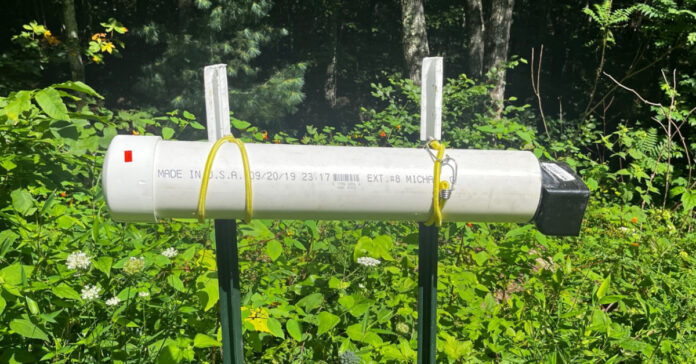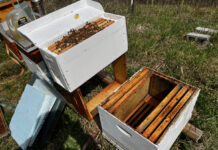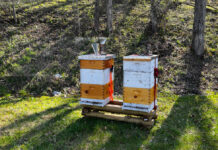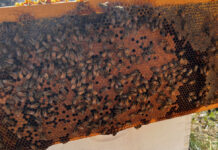
I made a road trip to my favorite beekeeping supply depot last week. What makes this road trip different from my usual trips is it goes in the opposite direction. Instead of heading towards a big city, I headed deeper into the state, following a series of two-lane roads through the mountains until we finally drop a couple thousand feet and broke into a four-lane highway. This was a state road, not an Interstate. As a result, there were very few 18-wheelers and light traffic overall. I didn’t see a cop the whole time.
It’s interesting to travel through the country off the Interstate from time to time because you get a different experience. I didn’t see a single Chick-fil-A restaurant or a Subway, but plenty of local hole-in-the walls where you could get a burger or a chicken fried steak and a waitress who called you “Hon.” There were no highway intersections with four gas stations, no rest areas, and no truck stops. There were lots of garden centers and farm stores and a couple of places that sold grass-fed beef direct to the consumer. It’s a different, less commercial view of American when you stick to the back roads.
I passed through a touristy area where you could go on zip lines or take a whitewater rafting trip. Later I went through a town that hosted a small college I doubt anyone from out of the state has heard of.
Bee Supplies
The item I needed most was some Apivar miticide to treat my hives for Varroa mites after I pull the honey supers off. That’s a small enough item that I could have had it mailed to me, but I also wanted to buy some more glass jars and plastic honey bottles. They take up a great deal of volume, which makes shipping them cost-prohibitive. I also picked up 72 bottles for another local beekeeper, so they didn’t have to make the trip.
Just as important as the bee supplies, they let me pick through their scrap wood and I brought home four boxes of kiln-dried scraps from bee frames to use as kindling. This stuff is so burnable, you can hold a lighter to it and it will ignite. Throw a few pieces on a bed of coals in the morning, and you’ll have a fire going again in minutes. I picked up enough to last at least a year. All at no charge.
This kindling not only saves us the trouble of splitting logs into smaller and smaller pieces, it eliminates any chance of injury.
Bee Feed
I bought a 40-pound bag of powdered pollen supplement, which I plan to feed the bees during the dearth. By using open feeding and treating the hives with miticide, I should have healthy and happy bees. That’s important because the next generation of bees will raise the bees that have to live through the winter. The pollen substitute will help ensure the fat-body winter bees have the nutritional resources they need to survive the cold.
I had planned to pick up some 4-inch PVC pipe on the trip to make my own feeders, but my truck was pretty full and the hour was getting late, so I just headed home. The next day, I went to my favorite plumbing supply store and bought the pipe and the necessary fittings. They asked me if I wanted a 10-foot of a 20-foot pipe, and I asked if it was possible to get just a few feet. Sure, they said they would cut it for me and sell it to me by the foot. So I got four feet, enough for two feeders, and it saved me from buying all ten feet.
I assembled the feeders, as seen in the photo. This is a temporary use and won’t be under any pressure, so I didn’t even bother to use glue as the pieces press-fit together tightly. That makes this one of the easiest projects I’ve done all year.
I put the pollen supplement in the feeder and the bees are not visiting it. That means there is no lack of pollen. When I set out some old honey equipment for the bees to clean out, they flocked to it to clean up the honey residue. This tells me there is not enough nectar coming into the hives. I can’t feed them sugar water while they are making honey and I won’t feed them while I treat the hives, but the goldenrod is starting to bloom, so that should carry them through the next few weeks.
Harvest is Coming
If the weather holds, and a high pressure system forming over the center of the country points towards that possibility, I’ll put on the escape boards later this week and pull the supers two days later. We should have all our 2023 honey harvested, extracted, and bottled within the next week or two.
Green bean season is drawing to a close. It’s a good thing green beans are one of our standby vegetables for dinner because our freezer is chock full of them.
Our zucchini harvest continues. My wife picked ten zucchini on one day last week and then five more four days later. They show no sign of slowing down. When we miss one and it grows too big, we feed it to the chickens. They gobble them up, eating the seeds first, the flesh second, and finally the skins. I am also feeding the chickens wild apples I pick up off the ground when I walk the dog. There are some large, plump apples up in the trees, but far too high for us to reach. Despite the unusual spring weather, all the trees I know of but one, which usually has yellow apples, are nicely fruited out.
The apples on the ground attract all sorts of wildlife, including bears. There have been four bear sightings in our neighborhood this year, the most since I’ve lived here. My wife spotted one. Security cameras caught a sow with a cub and another sow had two cubs. One young male bear wandered into a carport of a neighbor down the mountain. The bears rarely make a pest of themselves and shy from contact with humans. That doesn’t stop me from going armed, just in case. There have been multiple stories in the national news this year about people being killed our mauled by bears. Not if I have anything to do with it.






